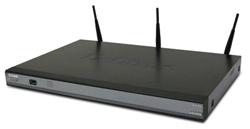 Two seemingly unrelated announcements last week have got me thinking about whether the future of “full screen” Internet TV applications, such as Joost or Babelgum, reside on a PC or, instead, some sort of set-top-box which connects to a TV.
Two seemingly unrelated announcements last week have got me thinking about whether the future of “full screen” Internet TV applications, such as Joost or Babelgum, reside on a PC or, instead, some sort of set-top-box which connects to a TV.
Microsoft launched a Beta version of its new MSN Video-based “Internet TV” service, compatible with “Extenders for Media Center” devices from Cisco, D-Link, and HP; and Jaman published a software hack — albeit, unsupported — to enable content from its movie download store to work with the AppleTV.
Other online video services to have already aligned with hardware manufacturers include BitTorrent, which released an SDK for set-top boxes, Network-Attached Storage (NAS) devices, and media extenders; Google-owned YouTube with their strong partnership with Apple; and DivX who are busy shopping around their “Connected” media extender hardware reference design to Asian consumer electronics companies.
What all of the above companies are betting, to varying degrees, is that for all the social and interactive advantages of online video, certain kinds of content, particularly long form programing, still wants to be viewed from the couch on a large widescreen TV.
Where does that leave Joost?
 However, notably absent from that list is Joost, which explicitly aims to emulate the “lean back” experience of television. Yet, despite CEO Mike Volpi touting the possibility, the Internet TV service doesn’t currently run on any kind of set-top-box. The same goes for almost all of the recent crop of full-screen streaming Internet TV apps: Babelgum, VeohTV (who have expressed their own set-top-box ambitions), and Next.TV. The exception, as already mentioned, is Microsoft’s newly launched “InternetTV”.
However, notably absent from that list is Joost, which explicitly aims to emulate the “lean back” experience of television. Yet, despite CEO Mike Volpi touting the possibility, the Internet TV service doesn’t currently run on any kind of set-top-box. The same goes for almost all of the recent crop of full-screen streaming Internet TV apps: Babelgum, VeohTV (who have expressed their own set-top-box ambitions), and Next.TV. The exception, as already mentioned, is Microsoft’s newly launched “InternetTV”.
Therefore, how long before we see Joost et al. roll out their own set-top-box strategies? And, perhaps more crucially (especially in light of the net neutrality debate) will those set-top-box partnerships be with consumer electronic companies who sell direct to consumers and whose products run on the “open” Internet or with telcos or cable companies who already offer IPTV services running on their own “closed” networks?

For those who keep asking, “why can’t the TV (or STB) process TV-web without the assistance of a networked PC?” the answer is simple. The chip inside a TV costs $15 or less. It is hard to get this chip to perform much the same function as a PC costing $100s. With the PC and TV working together there is also the option of combing PC-web with TV-web operation, with Web 2.0 mash-ups that have not yet been widely demonstrated, but likely offer significant opportunity for enterprising Web 2.0 developers. More at http://active-tv.blogspot.com
Visit http://www.online-tv-channels.net, here you can watch: Education, Entertainment, Kids & Youth, Movies, Music, News, Politics, Religion, Shopping, Sport and many more online TV Channels.